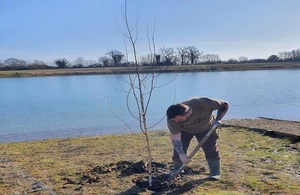Environment Agency works with angling clubs to plant 8,000 trees
Press release
Five angling clubs and the Middle Level Commissioners have benefited from a £10,000 tree investment to help wildlife, local communities and fisheries.

A member from one of the fisheries planting a tree. For each tree removed the Environment Agency plants 5 more in its place.
The Environment Agency recently distributed 8,000 trees between five fisheries and the Middle Level Commissioners as part of the compensatory planting project.
This project aims to replace dangerous trees that can cause harm to people and floods assets.
The Environment Agency worked in partnership with these organisations to identify areas that needed additional support.
Trees planted on designated embankments or in a state of ruin were removed and replaced.
For each tree removed the Environment Agency planted an estimated five more in its place.
Our fisheries officer presenting some of the trees to a fishery.
The Environment Agency provided the trees and angling club staff along with members of the local community worked together to remove trees in decline and replace them with native trees.
The fisheries which benefited from investment include:
-
Biggleswade and Hitchin Angling Association developed their Sandy New Road complex and Gingerbread lake.
-
Embryo Angling who developed the Broom Blue Lake Fishery.
-
Olney and Clifton Fishing Association developed a side channel off the main Great Ouse.
-
Milton Keynes Angling Association planted trees within their Bradwell Fishery.
-
River Lane Fishery expanded upon its existing planting program.
-
Middle Level Commissioners used 6500 young tree seedlings (whips) to plant two sections of land in the Fens.
The trees planted will offer a range of benefits such as providing shade and cover for fish while also contributing towards wildlife diversity.
Youngsters helped out to plant the trees too.
All trees planted were UK species such as alder, silver birch, oak, weeping willow, field maple, whips and many others.
Alex Malcolm, Environment Agency fisheries officer, said:
The 8,000 trees planted across East Anglia will provide great benefits to anglers and local communities while also improving wildlife biodiversity and habitats. Due to the complexity of our Fenland rivers, it is not always possible to replace trees in close proximity to the areas they have been removed from. However, it is fantastic that other fisheries and rivers have been able to benefit from this work. We hope the trees can grow well over the coming years and contribute to improved fisheries and biodiversity in their local areas.
Published 7 April 2021